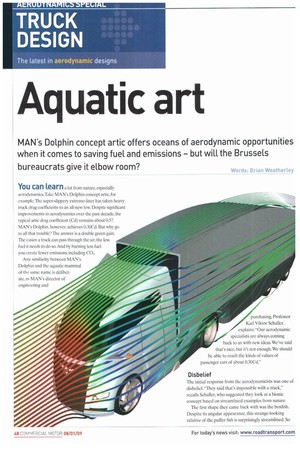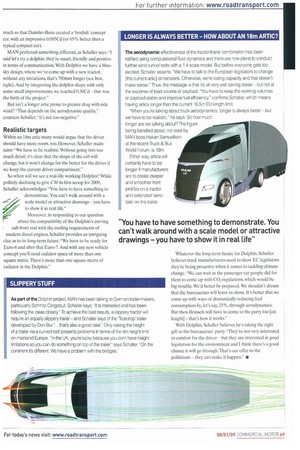Aquatic art
Page 48

Page 49

If you've noticed an error in this article please click here to report it so we can fix it.
MAN's Dolphin concept artic offers oceans of aerodynamic opportunities when it comes to saving fuel and emissions but will the Brussels
bureaucrats give it elbow room? Words: Brian Weatherley You can Learn a lot from nature, especially aerodynamics. Take MAN's Dolphin concept artic, for example. The super-slippery extreme-liner has taken heavy truck drag coefficients to an all-new low. Despite significant improvements in aerodynamics over the past decade, the typical attic drag coefficient (Cd) remains about 0.57. MAN's Dolphin. however, achieves 030Cd. But why go to all that trouble? The answer is a double green gain. The easier a truck can pass through the air, the less fuel it needs to do so. And by burning less fuel you create fewer emissions. including CO2.
Any similarity between MAN's Dolphin and the aquatic mammal of the same name is deliber.-ate, as MAN's director of engineering and purchasing, Professor Karl Viktor Schaller, explains: "Our aerodynamic specialists are always coming back to us with new ideas. We've said that's nice, but it's not enough. We should be able to reach the kinds of values of passenger cars of about 0.30Cd."
Disbelief
The initial response from the aerodynamicists was one of disbelief "They said that's impossible with a truck," recalls Schaller, who suggested they look at a bionic concept based on streamlined examples from nature. The first shape they came back with was the boxfish. Despite its angular appearance, this strange-looking relative of the puffer fish is surprisingly streamlined. So much so that Daimler-Benz created a `boxfish' concept car, with an impressive 0.095Cd (or 65% better than a typical compact car).
MAN preferred something different, as Schaller says: -I said let's try a dolphin, they're smart, friendly and positive in terms of communication. With Dolphin we have a bluesky design, where we've come up with a new tractor, without any imitations, that's 700mrn longer (see box, right). And by integrating the dolphin shape with only some small improvements, we reached 0.30Cd that was the birth of the project."
But isn't a longer artic prone to greater drag with side wind? "That depends on the aerodynamic quality," counters Schaller. "it's not too negative."
Realistic targets
Within an 18m artic many would argue that the driver should have more room, too. However, Schaller maintains:"We have to be realistic. Without going into too much detail, it's clear that the shape of the cab will change, but it won't change for the better for the driver if we keep the current driver compartment."
So when will we see a real-life working Dolphin? While politely declining to give CM its first scoop for 2009, Schaller acknowledges: "You have to have something to demonstrate. You can't walk around with a scale model or attractive drawings you have to show it in real life."
Moreover, in responding to our question about the compatibility of the Dolphin's curving cab front end with the cooling requirements of modern diesel engines, Schaller provides an intriguing clue as to its long-term future. "We have to be ready for Euro-6 and after that Euro-7. And with any new vehicle concept you'll need radiator space of more than one square metre.There's more than one square metre of radiator in the Dolphin." Whatever the long-term future for Dolphin, Schaller believes truck manufacturers need to show PC legislators they're being proactive when it comes to tackling climate change. "We can wait as the passenger car people did for them to come up with CO2 regulations, which would be big trouble. We'd better be prepared. We shouldn't dream that the bureaucrats will leave us alone. It's better that we come up with ways of dramatically reducing fuel consumption by, let's say, 25%, through aerodynamics. But then Brussels will have to come to the party too [on lengths that's how it works."
With Dolphin. Schaller believes he's taking the right gift to the bureaucrats' party. "They're not very interested in comfort for the driver but they are interested in good legislation for the environment and I think there's a good chance it will go through.That's our offer to the politicians they can make it happen.•








































































































































